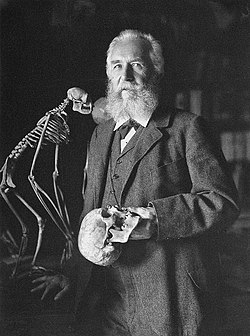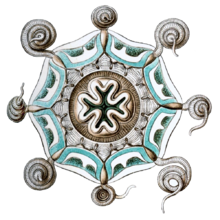Ернст Хекел
| Ернст Хекел Ernst Heinrich Philipp August Haeckel | |
| германски естественик и философ | |
 | |
| Роден |
16 февруари 1834 г.
|
|---|---|
| Починал | |
| Учил в | Хумболтов университет на Берлин |
| Научна дейност | |
| Област | Биология |
| Учил при | Хумболтов университет на Берлин, Вюрцбургски университет, Йенски университет. |
| Работил в | Йенски университет |
| Ернст Хекел в Общомедия | |
Ернст Хайнрих Филип Аугуст Хекел (на немски: Ernst Heinrich Philipp August Haeckel 16 февруари 1834–9 август 1919) е немски зоолог, натуралист, евгеник, философ, лекар, професор, морски биолог и художник, който открива, описва и назовава хиляди нови видове и картографира генеалогично дърво, свързващо всички форми на живот, освен това създава много термини в биологията, включително думите екология[1], phylum/тип(биология)[2], филогенеза[3] и Протисти[4].
Хекел популяризира и популяризира работата на Чарлз Дарвин в Германия[6] и разработи влиятелната, но вече не широко разпространена теория за рекапитулацията („онтогенезата рекапитулира филогенезата“), твърдейки, че биологичното развитие на отделния организъм, или онтогенезата, е паралел и обобщава еволюционното развитие на неговия вид, или филогенезата. Професор по зоология в Йенския университет (1862 – 1919).
През 1866г. Хекел се среща с Чарлз Дарвин и става един от най-пламенните привърженици на неговата теория. Пътува много и се запознава с фауната на много морета по земното кълбо. Прави изследвания върху морфологията на низшите животни.
Публикации[редактиране | редактиране на кода]



Книгата на Дарвин от 1859г. „За произхода на видовете“ има огромно популярно влияние, но въпреки че продажбите ѝ надхвърлят надеждите на издателя, това е по-скоро техническа книга, отколкото научно-популярно произведение: дълга, трудна и с малко илюстрации. Една от книгите на Хекел дава много, за да обясни на света неговата версия на „дарвинизма“. Това е бестселър, провокативно илюстрирана книга на немски език, озаглавена Natürliche Schöpfungsgeschichte, публикувана в Берлин през 1868 г. и преведена на английски като „История на сътворението“ през 1876г. До 1909г. се появяват единадесет издания, както и 25 превода на други езици. Natürliche Schöpfungsgeschichte затвърждава репутацията на Хекел като един от най-силните популяризатори на науката в Германия. Неговите Welträthsel са препечатани десет пъти след първата публикация на книгата през 1899г.; в крайна сметка са продадени над 400 000 копия[5].
Хекел твърди, че човешката еволюция се състои точно от 22 фази, като 21-вата – „липсващото звено“ – е средна стъпка между маймуните и хората. Той дори официално нарече това липсващо звено Pithecanthropus alalus, преведено като „човеко-маймуна без реч“[6].
Литературната серия от научни книги на Хекел е обширна, включваша научни статии и илюстрации[7].
Монографии[редактиране | редактиране на кода]
- Radiolaria (1862)
- Siphonophora (1869)
- Monera (1870)
- Гъби Calcareous (1872)
Открития с корветата Чалънджър[редактиране | редактиране на кода]
- Deep-Sea Medusae (1881)
- Siphonophora (1888)
- Deep-Sea Keratosa (1889)
- Radiolaria (1887)
Книги по биология и по философия[редактиране | редактиране на кода]

- Generelle Morphologie der Organismen: allgemeine Grundzüge der organischen Formen-Wissenschaft, mechanisch begründet durch die von Charles Darwin reformirte Descendenz-Theorie. (1866) Berlin (General morphology of organisms: general foundations of form-science, mechanically grounded by the descendance theory reformed by Charles Darwin)„Обща морфология на организмите“
- Natürliche Schöpfungsgeschichte (1868); in English The History of Creation (1876; 6th ed.: New York, D. Appleton and Co., 1914, 2 volumes)
- Freie Wissenschaft und freie Lehre (1877), in English, Free Science and Free Teaching
- Die systematische Phylogenie (1894) – Systematic Phylogeny
- Anthropogenie, oder, Entwickelungsgeschichte des Menschen (in Italian). Torino: UTET. 1895. изд.Акация,гр.София, 1924 г.
- Die Welträthsel (1895–1899), also spelled Die Welträtsel – in English The Riddle of the Universe, 1901
- Über unsere gegenwärtige Kenntnis vom Ursprung des Menschen (1898) (On our current understanding of the origin of man) – in English The Last Link, 1898
- Der Kampf um den Entwickelungsgedanken (1905) (The struggle over thought on evolution) – in English:Last Words on Evolution, 1906
- Die Lebenswunder (1904) – in English The Wonders of Life.Чудесата на живота, изд. Ив. Гладневъ, Габрово, 1907г.
- Kristallseelen : Studien über das anorganische Leben (1917) (Crystal souls: studies on inorganic life)
- „История на създаването на организираните животни според природните закони“
- „История на човешката еволюция“
- „Световните загадки“, Ст. Атанасовъ, гр.София, 1910г.
Пътеписи[редактиране | редактиране на кода]
- Indische Reisebriefe (1882) – Travel notes of India
- Aus Insulinde: Malayische Reisebriefe (1901) – Travel notes of Malaysia
- Kunstformen der Natur (1904) – Art forms of Nature, Digital Edition (1924)
- Wanderbilder (1905) – "Travel Images"
- A visit to Ceylon
Източници[редактиране | редактиране на кода]
- ↑ Haeckel, Ernst (1866). Generelle Morphologie der Organismen [The General Morphology of Organisms] (in German). vol. 2. Berlin, (Germany): Georg Reimer. From p. 286: "Unter Oecologie verstehen wir die gesammte Wissenschaft von den Beziehungen des Organismus zur umgebenden Aussenwelt, wohin wir im weiteren Sinne alle "Existenz-Bedingungen" rechnen können." (By "ecology" we understand the comprehensive science of the relationships of the organism to its surrounding environment, where we can include, in the broader sense, all "conditions of existence".)
- ↑ Haeckel, Ernst (1866). Generelle Morphologie der Organismen [The General Morphology of Organisms] (in German). vol. 1. Berlin, (Germany): G. Reimer. pp. 28–29. Haeckel noted that species constantly evolved into new species that seemed to retain few consistent features among themselves and therefore few features that distinguished them as a group ("a self-contained unity"). "Wohl aber ist eine solche reale und vollkommen abgeschlossene Einheit die Summe aller Species, welche aus einer und derselben gemeinschaftlichen Stammform allmählig sich entwickelt haben, wie z. B. alle Wirbelthiere. Diese Summe nennen wir Stamm (Phylon)." (However, perhaps such a real and completely self-contained unity is the aggregate of all species which have gradually evolved from one and the same common original form, as, for example, all vertebrates. We name this aggregate [a] Stamm [i.e., race] (Phylon).)
- ↑ (Haeckel, 1866), vol. 1, p. 29: "Die Untersuchung der Entwicklung dieser Stämme und die Feststellung der genealogischen Verwandtschaft aller Species, die zu einem Stamm gehören, halten wir für die höchste und letzte besondere Aufgabe der organischen Morphologie. Im sechsten Buche werden wir die Grundzüge dieser Phylogenie oder Entwicklungsgeschichte der organischen Stämme (Kreise oder "Typen") festzustellen haben." (The investigation of the evolution of these phyla and the identification of the genealogical kinship of all species that belong to a phylum—we deem [this] the highest and ultimately specific task of organic morphology. In the sixth book, we will have to establish the outline of this "phylogeny" or history of the evolution of the organic phyla (groups or "types").)
- ↑ CITATION Close [5] (Haeckel, 1866), vol. 1, pp. 215 ff. From p. 215: "VII. Character des Protistenreiches." (VII. Character of the kingdom of Protists.) From p. 216: "VII. B. Morphologischer Character des Protistenreiches. Ba. Character der protistischen Individualitäten. Der wesentliche tectologische Character der Protisten liegt in der sehr unvollkommenen Ausbildung und Differenzirung der Individualität überhaupt, insbesondere aber derjenigen zweiter Ordnung, der Organe. Sehr viele Protisten erheben sich niemals über den morphologischen Werth von Individuen erster Ordnung oder Plastiden." (VII. B. Morphological character of the kingdom of protists. Ba. Character of the protist Individualities. The essential tectological character of protists lies in the very incomplete formation and differentiation of individuality generally, however particularly of those of the second order, the organs. Very many protists never rise above the morphological level of individuals of the first order or plastids.)
- ↑ Daum 1998, pp. 305 – 6
- ↑ Schmutz, Hans-Konrad (1984). „Hypothetische Bindeglieder zwischen Affe und Mensch: Zur fossilarmen Frühgeschichte der Paläoanthropologie“. Sudhoffs Archiv. 68 (1): 77 – 83. JSTOR 20776898
- ↑ „Ernst Haeckel“. WorldCat.
Вижте също[редактиране | редактиране на кода]
|
